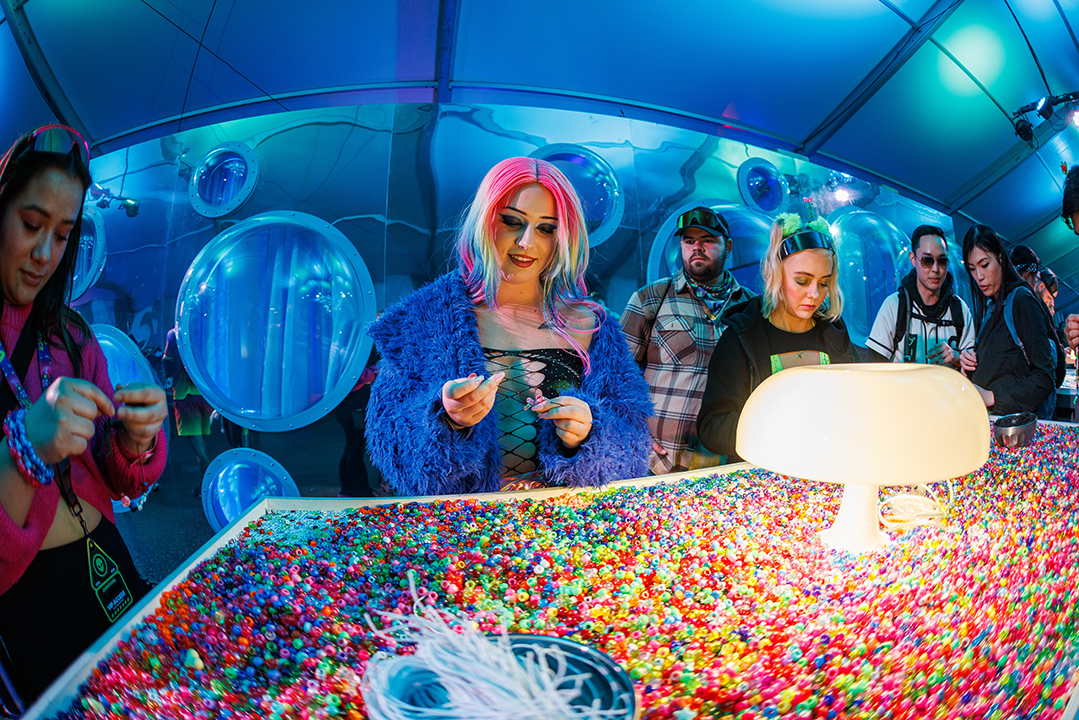Beyond the music, rave culture is defined by traditions that run deep in the genre’s history, and kandi is one of the most iconic pieces of this history.
The brightly colored bead accessories have been a staple image of US rave culture throughout multiple decades, and ravers still pour precious time and love into the craft as other trends come and go. Thanks to this, kandi remains an unmistakable symbol of rave culture– but another music fandom is shaking things up with its own bling.
As Taylor Swift’s massively popular ERAS tour took the country by storm, a curious trend among the pop superstar’s followers has pulled ravers’ attention. Seemingly out of nowhere, Swifites started sporting friendship bracelets that look just like kandi– leaving many ravers scratching their heads.
Did Taylor Swift fans “steal” kandi from ravers? While the simple answer to this question is no, the debate reveals an interesting story about how a simple bead bracelet became the symbolic staple of an entire culture– and questions if any single group can truly claim the tradition.

Same Materials, Different Origin Stories
So, where did it all start? Accounts of people using bead-making and trading as a means of signaling social bonds and identities exist all throughout human history.
Friendship bracelets became a popular trend among kids in the 80s and 90s, and some people suggest that both kandi and Taylor Swift’s modern version of the accessory draw their origins there.
According to Taylor Swift fans, friendship bracelets started trending in response to the track “You’re On Your Own Kid,” in which Swift reflects on her childhood and having to grow up faster than other kids her age.
Jamie Deese, a raver who is also a dedicated Taylor Swift fan explains further: “There’s one line in the song that says, ‘So make the friendship bracelets and take the moment and taste it,’” she explains. “I think it was a nostalgic thing for a lot of her (Swift’s) adult fans because she’s saying take the time to enjoy the little things in life. Do it, even if people think it’s silly.”
I was instantly reminded of kandi-clad ravers with bracelets all the way up their arms– it’s not hard to imagine why some people are convinced Swift fans must have taken the idea from ravers. Nonetheless, Deese insists the two trends are not related.
The story of how kandi became part of rave culture has a few different versions. Some claim that the bracelets were originally made from real candy, and that bead bracelets in general were used as a form of drug paraphernalia in the underground.
Some venues even banned kandi bracelets in the 90s and early 2000s because of the association; nonetheless, they became a fashion trend among underground circuits. Over time, ravers started making and trading kandi as a means to ritualize and promote values like peace, love, unity, and respect (PLUR) and to signal belonging to the scene.

Kandi: The Bracelet That Became The Centerpiece Of A Movement
Today, kandi generally plays three roles in rave culture. First, people use the accessories as an identity badge–a signal that communicates being a proud raver.
David Michael, founder of the online kandi shop KandiBar explains that many of his customers first come to his business looking for inspiration in light of this: “I think for a lot of people, it’s a way that they signal their membership in the community. And it also says I’m open to you talking to me like if I’m wearing kandi–I’m also a part of this community,” he explains.
Michael developed a passion for making connections with people over trading kandi when he first started raving. Spreading these “magical moments of connection” ultimately inspired him to kick-start his company KandiBar.
Trading and gift-giving kandi is also a core tradition in rave culture. The practice is so integral that there’s a special handshake dedicated to it (see video below). Many ravers can think of a time when they connected with a stranger by trading kandi, and the accessories even bring ravers together in the regular world.
Deese, for example, once bonded with a Starbucks barista when she pointed out the kandi bracelet around her wrist. I’ve had many similar experiences of finding ravers in the wild this way myself, and even when these interactions last only a few minutes or seconds, there’s something wonderful about the sense of belonging that they bring.
Many people also find beauty in the crafting process of making kandi. Novices and kandi Picassos alike use kandi as a fun creative outlet for self-expression. People often do this by creating short phrases (typically something funny, uplifting, or dedicated to commemorating the event) in their designs.
In my experience, receiving an uplifting message on a piece of kandi always makes for a memorable moment, and for Michael, crafting kandi is an opportunity to spread positivity: “When I work with a team and with creators to put together the Kandi phrases that we’re going to publish every year, we take it as seriously as songwriting.”
He explains. “We have to be responsible for the fact that we’re putting these messages out into the world. It’s serious business making people happy.”
When Two Worlds Collide
Kandi culture is intimately tied to the US dance music history and its idyllic values, namely peace, love, unity, and respect (PLUR). That said, not all ravers are reacting in a positive way to Taylor Swift fans’ “kandi-adjacent” friendship bracelet trend. It appears that some people jumped to the conclusion that Swift fans took the idea from rave culture without credit, and that the trend is an imposition.
As discussed, this is inaccurate because the two trends evolved separately. The clash illuminates the fact that the rave community appears to be experiencing a bit of an identity crisis–seasoned ravers fear that the culture they know and love is eroding as the scene becomes more popular.
We hear it everywhere. The dance music community now appears to be bumping up against its own values as a desire to preserve its core values against a perceived loss of identity is driving a move toward exclusion and tribalism. The friction with Swift’s fandom is just the latest evolution.
Still, there are those who believe this reaction is making mountains out of molehills and that ravers who respond with hostility are in-fact doubling back on their own supposed values: “I actually saw a few Tiktoks from ravers saying Swifties are stealing Kandi from ravers and like ‘how dare they’ and I didn’t find that to be very ‘peace love unity and respect’, which is the whole point of kandi, in my opinion.” Deese explains.
She believes the friendship bracelet trend will likely pass anyway, especially since it’s time-bound to Swift’s ERAS tour. In the meantime, she sees an opportunity for Swift fans and ravers to bond rather than clash: “If you’re gonna talk about unity, Swifties and EDM people can unite. Just let them call it friendship bracelets, and you can still wear your kandi and do your thing with it. Like the world will still keep turning, it’s going to be okay.”

Michael has a similar attitude: “ If we take PLUR seriously, and we take the point of Kandi seriously, then that tradition spreading to new communities is just a net positive for humanity, whether or not it looks exactly like the way that we do it. The rave community getting credit or perpetuating a very specific ritual is not the point.”
“There are so many harsh things in the world, and there is a time and place to focus on solving those issues, and there is a time and place to let people recharge and reconnect with their inner child and reconnect with their friends and their families and that kind of stuff. people want a way to express themselves. They want a way to create connections with others. They meet at live events, and they want to build community, and Kandi is a really great way to do that. And for the Taylor Swift community to pick up on that tradition, I think the more the merrier. Welcome.”
Kandi has a unique history as a well-established part of rave culture, and it’s hard to imagine that a Taylor Swift fan wearing friendship bracelets could topple the whole tradition.
It seems that the fear of loss is overpowering some people’s ability to remember that these crafts are just supposed to be a playful way for music fans to connect. They exist because they help people have fun, connect with one another, and connect to a childlike sense of innocence in a stressful world.
Cover Image by Insomniac.







